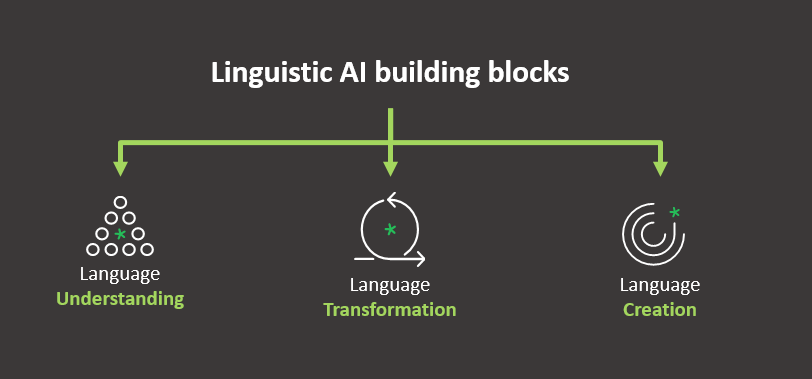What linguistic AI has learned
21 May 2019
 8 min read
8 min read

Since the launch of Linguistic AI (Artificial Intelligence) over a year ago it has been a busy period for our technology development team. At our Executive Summits throughout 2018, we introduced customers to Hai, our Linguistic AI, which is based on 27 years R&D across artificial intelligence, natural language processing (NLP), natural language generation (NLG), neural networks, deep learning, linguistics, and so much more.
RWS's customers have reaped the benefits of our work in this space through Language Weaver, a state-of-the-art solution for neural machine translation that solves advanced content challenges across industries. But machine translation isn’t the only area Linguistic AI contributes to. To better understand how we apply Linguistic AI, let’s consider Linguistic AI possibilities and to do that, we need to go back to the basic building blocks of working with language:

Linguistic AI. The building blocks explained
Language Understanding captures the ability to leverage a variety of deep learning algorithms to find meaning in the noise that is content. Sounds simple, but when you’re dealing with mountains of content, it becomes incredibly complex. While some categorize anything that analyzes content as NLP (Natural Language Processing) it takes more than turning words into data structures--the 1s and 0s that computers still need to make sense of data—to help people that are adding value to the many steps along the content supply chain. RWS doesn’t take the human out of the equation. Language understanding is enabling humans and machines to work together to better understand the massive amounts of content we use every day in a meaningful way.
Language Transformation is the part where we are taking a machine-first approach to enable another machine or human with output that has been changed in some ways. Translation is the easiest transformation to use as an example, but it could also be a new document hierarchy that transforms not just the form of the content, but the context for the content. Language transformation allows RWS to globalize chatbots, enable translators to work more efficiently, and identify the most important web content to localize. It is the machine being able to find the patterns and insight in content and then apply what it’s learned to a new workflow.
Language Creation is both at the end and the beginning. Linguistic AI needs content to understand and transform and Linguistic AI can be leveraged to create new content as well. We are not talking about a machine writing the next great novel, or suggesting that creative writing and marketing no longer needs humans. Linguistic AI can help the writer with a jump start born of what has been done and has proven itself effective. We wrote about how content is becoming autonomous just recently here.
Applying Linguistic AI to Content Challenges
After a year of working on advancing this technology, RWS is now ready to activate it to minimize the friction we find across business process that are heavily reliant on content. For example:
- Adaptable Language Pairs for RWS's machine translation – this is a new innovation that provides the ability for an expert to adapt AI securely, behind a firewall and deploy it securely across the firewall.
- Intelligent routing of work to translators based on content characteristics – this is a capability that can be paired with machine translation to create an optimized, machine-first content localization workflow.
- Derivative content creation – the ability to break content into parts that can be assembled and re-assembled can be a game-changer for marketers.
These are just some of the things we are actively doing with Linguistic AI today, and we are continuing to work on adding depth and breadth to what we have in market.

